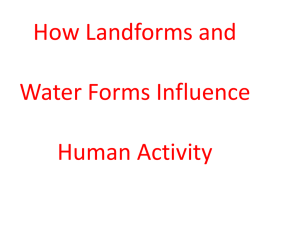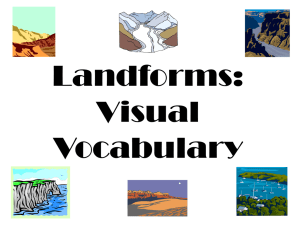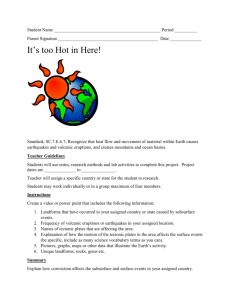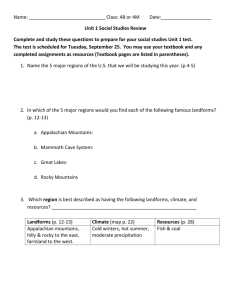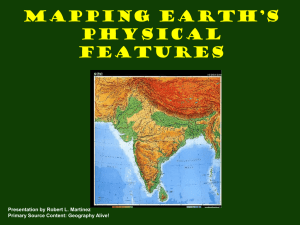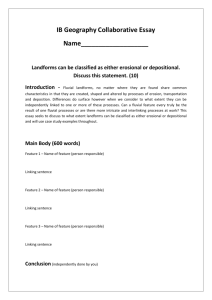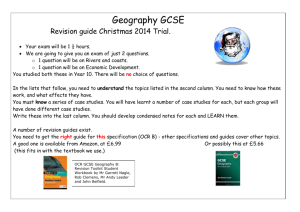grl52980-sup-0001-WattersSupInfo
advertisement
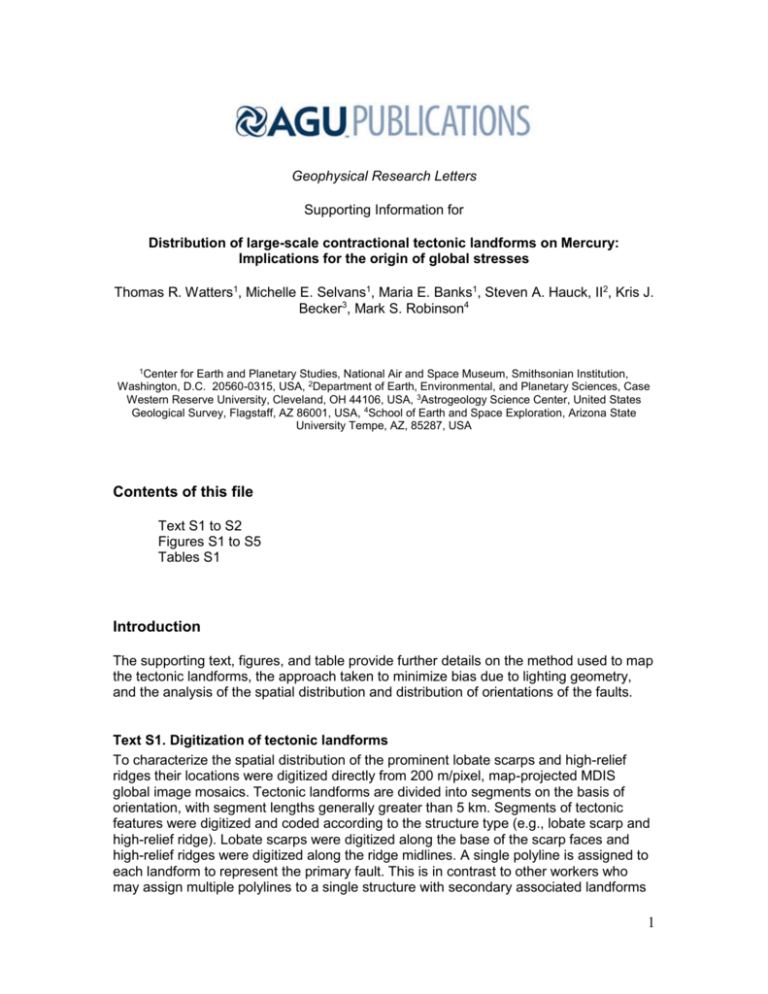
Geophysical Research Letters Supporting Information for Distribution of large-scale contractional tectonic landforms on Mercury: Implications for the origin of global stresses Thomas R. Watters1, Michelle E. Selvans1, Maria E. Banks1, Steven A. Hauck, II2, Kris J. Becker3, Mark S. Robinson4 1Center for Earth and Planetary Studies, National Air and Space Museum, Smithsonian Institution, Washington, D.C. 20560-0315, USA, 2Department of Earth, Environmental, and Planetary Sciences, Case Western Reserve University, Cleveland, OH 44106, USA, 3Astrogeology Science Center, United States Geological Survey, Flagstaff, AZ 86001, USA, 4School of Earth and Space Exploration, Arizona State University Tempe, AZ, 85287, USA Contents of this file Text S1 to S2 Figures S1 to S5 Tables S1 Introduction The supporting text, figures, and table provide further details on the method used to map the tectonic landforms, the approach taken to minimize bias due to lighting geometry, and the analysis of the spatial distribution and distribution of orientations of the faults. Text S1. Digitization of tectonic landforms To characterize the spatial distribution of the prominent lobate scarps and high-relief ridges their locations were digitized directly from 200 m/pixel, map-projected MDIS global image mosaics. Tectonic landforms are divided into segments on the basis of orientation, with segment lengths generally greater than 5 km. Segments of tectonic features were digitized and coded according to the structure type (e.g., lobate scarp and high-relief ridge). Lobate scarps were digitized along the base of the scarp faces and high-relief ridges were digitized along the ridge midlines. A single polyline is assigned to each landform to represent the primary fault. This is in contrast to other workers who may assign multiple polylines to a single structure with secondary associated landforms 1 [e.g., Di Achille et al., 2012; Byrne et al., 2014]. Pre-orbital phase surveys of tectonic landforms based on Mariner 10 [Watters et al., 2004] and MESSENGER flyby [Watters et al., 2009a] image coverage were used to locate and verify previously mapped lobate scarps and high-relief ridges. Image parameters important for the detection of tectonic landforms are incidence angle, solar azimuth or illumination direction at the surface, and pixel scale. Incidence angle is defined as the angle between the local solar vector and the surface normal (projected onto a cartographic sphere or ellipsoid). Images obtained with low incidence angles (near local noon) are optimal for revealing subtle reflectance variations (compositional or maturity differences). Large incidence angle images (near terminator) are optimal for revealing subtle topographic relief (e.g. tectonic landforms that have low relief and surface slopes of only a few degrees). The illumination azimuth (compass direction towards sub-solar point) is equally important to the detection of tectonic landforms because linear features with orientations parallel to the solar azimuth may not be apparent (fewer shadows are being cast and topographic fall-off in reflectance is suppressed). The orientations of the large-scale contractional landforms mapped in this study are roughly N–S at low to mid-latitudes and E–W at high latitudes. This could be due to observational bias where features oriented perpendicular to the local illumination direction are expected to be preferentially enhanced [see Melosh and McKinnon, 1988; Watters et al., 2004], since at the equator the illumination direction is east or west and at the poles the illumination direction is north or south. The tectonic map of Byrne et al. [2014], and used by Klimczak et al. [2015], is based on a monochrome global mosaic of images obtained during the first solar day of MESSENGER’s orbit that vary greatly in incidence angle and solar azimuth direction. They attribute longitudinal bands in the density of their mapped contraction tectonic landforms as an effect of lighting bias [Byrne et al., 2014; Klimczak et al., 2015]. In order to minimize the potential lighting geometry bias and maximize the detection of tectonic landforms, particularly low relief landforms, large incidence angle (65° to 88°) monochrome global mosaic sequences with opposite solar azimuth directions were obtained during the third and fourth solar day of MESSENGER‘s orbital imaging campaign. The large-scale lobate scarps and high-relief ridges form two pronounced and a third less pronounced concentrations that occur in broad longitudinal bands centered roughly at -90°, -30°, and 110°. The centers of the bands also correspond to peaks in the cumulative length of the structures plotted as a function of longitude (Figure 3C). To test the question of the influence of lighting bias on the location of the bands, a map of the distribution of incidence angles for images in the high incidence angle global mosaics was created and it shows that zones with the highest incidence angle coverage do not generally correspond to regions with larger concentrations of lobate scarps and highrelief ridges (Figure S1). Some zones with the highest incidence angle image coverage are located in areas where there are distinctly fewer large-scale contractional landforms (e.g., 40°N, -90°E). The large incidence angle mosaics also help minimize the effects of lighting bias on the detection of E-W oriented landforms at low and mid-latitudes because slopes greater than a few degrees are illuminated or cast shadows even on such landforms with low relief (a feature will cast a shadow if its slope is greater than 90° minus the incidence angle). To further minimize an incidence angle bias in the identification of E-W oriented tectonic features, digital elevation models (DEMs) generated from MLA data (northern hemisphere coverage, 32 pix/deg) [Zuber et al., 2012], stereo imaging (limited coverage in northern and southern hemisphere, ~220 m/pix) [Preusker et al., 2012], stereophotoclinometry (global coverage, 32 pix/deg), and control-point networks (global coverage, 16 pix/deg) [Becker et al., 2014] were used in 2 combination with the high incidence angle mosaics (color-coded topographic data was merged with image mosaics) to map tectonic landforms. A plot of the orientations of the mapped lobate scarp and high-relief ridge segments with latitude shows that in addition to a large number of segments with roughly N-S orientations (0°) at low to mid-latitudes (0° to ±60°), there are a large number of segments with orientations of ±30° to ±60° and from ±60° to ±90° (roughly E-W) at low to mid-latitudes (Figure S2). At high latitudes (greater than ±60°), there are a large number segments with roughly N-S orientations in addition to segments with E-W orientations (Figure S2). This analysis suggests that the dominance of east and west illumination at low and mid-latitudes has not prevented the detection of E-W oriented large-scale tectonic landforms in the equatorial zone, and that the dominance of north and south illumination at high latitudes has not prevented the detection of N-S oriented tectonic landforms in the polar regions. The most notable lobate scarp that significantly deviates from a N–S orientation is Enterprise Rupes (37°S, 74°E) with an approximately E–W orientations outside of the floor of Rembrandt basin (Figure 1A). The orientation of Enterprise Rupes changes to NE–SW where it crosscuts the Rembrandt basin. Other large-scale scarps with approximately E–W orientations are found at ~19°N, ~24°S, and ~50°S (Figure S3A, B, C). These lobate scarps suggest that a large number of E–W oriented scarps do not remain undetected. Additional confidence that large-scale contractional tectonic landforms are not likely to have been missed due to lighting bias is gained by examining wrinkle ridges in smooth plains. Wrinkle ridges typically have lower relief than lobate scarps yet ridges with E–W orientations have been identified, including wrinkle ridge rings (i.e., ghost craters) with segments of all orientations and found at all latitudes (Figure S4) [see Watters et al., 2009, 2012]. Digital elevation models provide a further means to evaluate if low-relief landform with small slopes at non-optimal orientations relative to the solar azimuth direction have been detected. Shaded relief maps can be generated with illumination directions that do not naturally occur at a given latitude. Evaluation of an area in the northern smooth plains (dominant solar illumination from the south) indicates that all major tectonic landforms revealed in shaded relief maps generated using an MLA derived DEM illuminated from the east, west, and north are detected in a high incidence angle mosaic (Figure S5). This includes a prominent NE-SW oriented, arcuate lobate scarp, roughly N-S as well as E-W oriented wrinkle ridges, and several ghost craters. The mean, median, weighted mean of orientations of the large-scale lobate scarps and high-relief ridges were sampled globally in areas with dimensions of 40° longitude by 20° latitude. Statistics of the measured orientations are shown in Table S1. Text S2. Smooth plains and wrinkle ridges The greatest expanses of smooth plains, the northern plains and the Caloris interior and exterior plains, are located by and large in the northern hemisphere [Denevi et al., 2013]. The number of lobate scarps in wrinkle ridge-dominated smooth plains is greatly less than in the intercrater plains [Watters et al., 2009; Watters and Nimmo, 2010]. Thus it is clear that large-scale, likely deeply rooted, thrust faults are not as prevalent in areas covered by smooth plains material. The dominance of flexure induced subsidence due to loading of thick volcanic deposits may contribute to partitioning of contractional strain preferentially within the smooth plains resulting in the formation of more shallow-rooted thrust faults (i.e., wrinkle ridges). The distribution of smooth plains alone, however, does not account for the dichotomy in large-scale tectonic landforms between the two hemispheres. Large expanses of intercrater plains in the northern hemisphere are found 3 (e.g., ~45°N, 75°W) where prominent lobate scarps and high-relief ridges are nearly absent. References Becker, K. J. et al. (2014), Progress towards a global digital elevation model for Mercury, Lunar Planet. Sci., 45, Abstract #2243. Byrne, P. K., C. Klimczak, A. M. C. Sengor, S. C. Solomon, T. R. Watters and S. A. Hauck (2014), Mercury: Global tectonics on a contracting planet, Nature Geosci., 7, 301-307. Denevi, B. W. et al. (2013), The distribution and origin of smooth plains on Mercury, J. Geophys. Res., 118, 891–907, doi:10.1002/jgre.20075. Di Achille, G., C. Popa, M. Massironi, E. Mazzotta Epifani, M. Zusi, G. Cremonese, and P. Palumbo (2012), Mercury’s radius change estimates revisited using MESSENGER data, Icarus, 221, 456-460. Klimczak, C., P. K. Byrne, and S. C. Solomon (2015), A rock-mechanical assessment of Mercury’s global tectonic fabric, Earth Planet. Sci. Lett., 416, 82–90. Preusker, F., J. Oberst, J. W. Head, M. S. Robinson, T. R. Watters and S. C. Solomon (2012), Topography of Mercury from stereo images: Regional terrain models from MESSENGER orbital mapping, EPSC Abstracts, 7, 2012-528. Watters, T. R., and F. Nimmo (2010), The tectonics of Mercury, in Planetary Tectonics, edited by T. R. Watters and R. A. Schultz, pp. 15–80, Cambridge University Press, Cambridge. Watters, T. R., Robinson, M. S. and Cook, A. C. (1998), Topography of lobate scarps on Mercury: New constraints on the planet’s contraction, Geology, 26, 991-994. Watters, T. R., M. S. Robinson, C. R. Bina, and P. D. Spudis (2004), Thrust faults and the global contraction Mercury, Geophys. Res. Lett., 31, L04701, 10.1029/2003GL019171. Watters, T. R., S. C. Solomon, M. S. Robinson, J. W. Head, S. L. André, S. A. Hauck II, and S. L. Murchie (2009), The tectonics of Mercury: The view after MESSENGER's first flyby, Earth Planet. Sci. Lett., 285, 283–296, doi:10.1016/j.epsl.2009.01.025. Zuber, M. T. et al. (2012), Topography of the northern hemisphere of Mercury from MESSENGER Laser Altimetry, Science, 336, 217-220. 4 Figure S1. Map of the distribution of incidence angles (65° to 88°) in images used for the global high incidence angle mosaics. The map show the combined east and west illumination direction images. The mapped large-scale contractional feature (black and grey lines) occur in broad bands centered approximately at -30° and 110° (black dashed lines). Zones with the highest incidence angles (areas in magenta, >85° incidence angles) do not correspond to the centers of the prominent bands where the scarps and high-relief ridges are more concentrated with the exception of a less prominent band centered roughly at -90°. This suggests that the bands of large-scale contractional faults and regions where there are distinctly fewer such features are not solely an artifact of lighting geometry. Gaps in the high- incidence-angle coverage are shown in white. Figure S2. Plot of orientations of all digitized large-scale lobate scarp and high-relief ridge segments (for landforms with total length >50 km) as a function of latitude. In the plot, 0° is N-S and ±90° is E-W. The plot shows there are a large number of segments with orientations between ±30° of N-S, particularly at the low to mid-latitudes. However, 5 the plot also shows a very large number of segments with orientations of ±30° to ±60° and from ±60° to ±90° at all latitudes. 6 Figure S3. High incidence angle mosaics of generally E-W oriented lobate scarps. A) Generally E-W oriented lobate scarps located in the northern hemisphere of Mercury (~19.5°N, 43.5°E). This scarp (white arrows) is ~400 km in length. B) Generally E-W oriented lobate scarp (white arrows) is ~170 km in length and is located in the southern hemisphere of Mercury (~24.5°S, 56°W). C) Belgica Rupes is generally E-W oriented and ~400 km long lobate scarp (white arrows). Belgica Rupes is located in the southern hemisphere of Mercury (~50°S, 64°E), approximately 450 km south of Enterprise Rupes. 7 Figure S4. High incidence-angle mosaic of wrinkle ridges in the smooth plains of Tir Planitia. Generally E-W oriented wrinkle ridges (vertical white arrows) occur among a network of ridges with various orientations. This includes wrinkle ridge rings or ghost craters (horizontal white arrows). The ridged plains of Tir Planitia are part of the Caloris exterior smooth plains located to the south of the basin (~10°S, 161°E) [Denevi et al., 2013]. 8 Figure S5. Comparison of a high incidence angle mosaic with shaded relief maps generated from an MLA derived DEM of an area in the northern smooth plains (~81°N, 12°E). (A) The mosaic, generated using high incidence angle images, shows a prominent, arcuate lobate scarp (center), roughly N-S and E-W oriented wrinkle ridges, and wrinkle ridge rings or ghost craters. (B) Shaded relief map generated with a simulated illumination direction of 270° (west) and a simulated incidence angle of 80°. (C) Shaded relief map generated with a simulated illumination direction of 90° (east) and a simulated incidence angle of 80°. (D) Shaded relief map generated with a simulated illumination direction of 0° (north) and a simulated incidence angle of 80°. All the major tectonic landforms detected in the high incidence angle mosaic are found in the shaded relief maps. 9 Longitude (deg.) -160 -160 -160 -160 -120 -120 -120 -120 -120 -120 -80 -80 -80 -80 -80 -80 -80 -80 -40 -40 -40 -40 -40 -40 -40 -40 0 0 0 0 0 0 40 40 40 40 40 40 80 80 80 80 80 80 80 120 120 120 120 120 120 120 160 160 160 160 160 160 160 Latitude (deg.) -80 -60 -40 -20 -60 -40 -20 0 20 40 -80 -60 -40 -20 0 20 40 60 -80 -60 -40 -20 0 20 40 60 -80 -40 -20 0 20 80 -80 -60 -40 -20 0 20 -80 -60 -40 -20 0 20 40 -80 -60 -40 -20 0 20 40 -80 -60 -40 -20 0 20 60 Mean 71.15 62.15 -22.53 29.31 8.2 12.19 25.93 16.47 7.81 30.11 88.84 48.47 2.69 -9.49 3.69 18.32 34.47 -3.97 -3.46 18.59 2.82 -5.85 6.72 5.33 -1.93 -44.46 -62.46 0.38 -2.39 -22.18 -13.85 39.68 -108.79 -41.11 -12.08 2.47 -16.21 32.62 -105.16 23.54 42.24 1.51 -10.31 26.55 -4.88 -11.39 -7.79 -2.2 -15.73 19.83 13.62 -4.1 110.17 9.61 19.75 9 10.36 32.49 5.21 Median 77.58 70.47 -24.68 35.65 0 8.11 27.49 14.29 11.38 17.95 111.7 49.41 1.09 -15.15 5.82 25.63 31.05 0 8.77 21.69 12.12 -4.66 5.1 5.06 -5.37 -51.65 -65.29 3.31 0 -24.32 -14.65 49.21 -110.38 -64.31 0 8.12 -22.04 28.79 -121.69 52.54 43.9 3.75 -16.33 36.11 1.09 -31.49 -11.86 -3.07 -18.81 25.05 5.24 -5.75 140.25 -15.61 35 20.4 6.64 48.62 13.59 Weighted Mean 80.98 65.13 -31.35 30.89 30.47 9.49 31.05 18.84 3.18 23.93 100.39 40.31 -2.13 -12.17 7.73 16.88 48.47 -9.41 7.2 10.43 4.18 -2.46 5.41 2.6 -1.15 -44.18 -65.64 -6.91 -3.07 -23.07 -15.79 48.82 -120.12 -35.04 -8.68 -4.32 -20.27 40.3 -125.45 24.53 52.56 2.42 -10.76 30.14 -10.73 -15.99 -6.05 0.33 -23.23 14.74 14.48 -8.26 117.99 6.73 25.91 13.55 10.3 43.5 6.73 Standard Deviation 45.61 60.28 26.35 28.07 68.06 42.51 29.35 35.01 30.74 61 43.86 50.17 31.34 36.16 33.8 28.57 25.1 24.76 46.15 30.64 34.47 40.48 24.98 22.57 28.64 28.94 30.09 31.95 25.88 24.87 24.19 23.18 60.36 61.98 40.12 29.88 35.91 41.85 71.72 69.35 30.49 40.52 32.06 26.56 15.17 113.57 70.03 33.73 42.28 35.99 31.99 27.98 69.2 65.76 38.3 36.33 20.3 29.72 20.79 Sum of Lengths (km) 135.96 1486.27 419.81 568.27 201.03 486.27 1709.24 901.27 774.39 264.8 305.65 1287.32 1902.46 1048.24 954.13 311.11 166.25 207.76 460.33 946.7 998.17 1505.55 698.57 1130.31 1574.8 473.08 411.7 1090.25 225.41 1719.26 439.59 111.03 174.15 449.58 560.7 835.99 641.76 990.88 749.2 491.86 1489.56 1210.28 1696.15 660.13 111.1 313.8 1823.33 1465.1 2598.21 1867.46 654.76 509.94 206.5 411.56 756.23 281.05 188.19 292.23 293.51 Table S1. Orientations of Prominent Lobate Scarps and High-Relief Ridges. Longitudes and 10 latitudes give the location centers of sampling areas. North is equal to 0 degrees. The weighted mean is weighted by segment length. 11
